President's Message - The Benefits of Membership
Sir John A. Macdonald Dinner 2006
Rivers West - Red River Corridor Association
The International Style of Architecture
The Manitoba Historical Society in partnership with the Hindu Society of Manitoba is holding a Spring Dinner and cultural evening Tuesday, April 4. The evening begins at 6:00 p.m. A Tour of the Temple begins at 5:30. The event will be held at the Dr. Raj Pandey Hindu Centre, 999 St. Anne’s Road.
Sample a variety of Indian dishes including pakoras, chhole, and mutter paneer. Enjoy lively entertainment by Indian performers. Dr. Suresh Bhatt from the University of Manitoba will be speaking on Hindu culture and religion and Indo-Canadians in Manitoba.
To avoid disappointment, book early for this popular event. Prepay $18.00 per person by cheque, Mastercard or Visa to the MHS office (204-947-0559) before March 28.
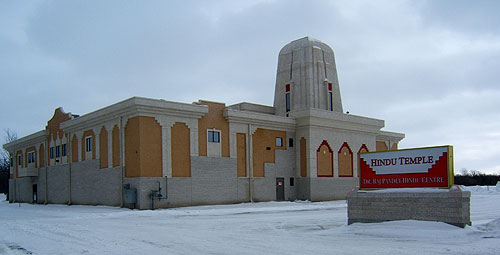
New members of the MHS are often not aware of the full scope of our activities. And I suspect that even long-time members do not know about all of the things we do. So the purpose of my column this month is to give you a brief description of the benefits of MHS membership and, at the end, to request your help. I will group things into four general categories: awards, publications, programs, and museums.
1. Awards
Centennial Farm – This program was initiated by the MHS in 1980 to recognize farms which have been operated continuously for 100 years or more by a single family. To date, over 1,200 farms have been so designated throughout southern Manitoba. Recipient families receive a plaque or certificate, usually at a formal presentation ceremony. A separate Century Farm program of the provincial government provides signs which recipient families post at their farm gate.
Centennial Business – In 1999, the MHS initiated the Manitoba Centennial Business Awards to recognize businesses that have operated continuously in the province for over 100 years. Changes in business location and ownership are permitted. Recipient businesses, of which there have been 52 so far, are presented with a commemorative plaque at the annual Macdonald Dinner or at an event sponsored by the recipient.
Centennial Organization – This program was started in 2004 as part of the MHS’s 125th anniversary celebrations. It commemorates 100 years of continuous operation by non-profit organizations, clubs, congregations, and associations in the areas of culture, economic development, education, health, heritage, labour, politics, recreation and sport, religion, and social reform. Twenty-six awards have been made to date, usually at an annual awards ceremony.
Margaret McWilliams – This award was instituted in 1955 as a memorial to Margaret S. McWilliams, a well-known Manitoba author, by her husband, former Lieutenant-Governor Roland F. McWilliams. Its purpose is to encourage the study and interpretation of the history of Manitoba. Certificates are presented at an annual awards ceremony to authors of scholarly books, popular books, works of historical fiction, local histories, institutional histories, essays, theses, displays, videos, and web sites.
Young Historians – This award program is open to all school children in the province to encourage them in producing essays, posters, models, and videos on themes from Manitoba history. Thirty-three awards were made at our most recent annual ceremony. The winner of the Dr. Edward Shaw Award (named in honour of the late MHS President and historian) for an outstanding senior essay has his or her work published in our journal, Manitoba History.
Douglas Kemp – This award was inaugurated in 1988 to recognize exceptional service in the promotion and preservation of Manitoba’s heritage, usually by an MHS member. It commemorates the late MHS President. This award is typically presented at the Annual General Meeting.
Charles Bell – This award was initiated in 2004 to recognize the student with the highest standing in the introductory course History of Canada (11.144) at the University of Manitoba. The award commemorates the life and work of Charles Napier Bell, who was President of the MHS from 1889 to 1891 and again from 1913 to 1929.
2. Publications
Time Lines newsletter – The newsletter, and its predecessor Keywords, is published every two months. It reports on MHS activities, advertises upcoming events and museum developments, and informs members about heritage news around the province and elsewhere.
Manitoba History journal – Manitoba History is a peer-reviewed journal which has been published since 1980. It is the only journal devoted to the history of Manitoba and it contains well researched, scholarly articles as well as articles of general interest, book reviews, advertisements, and an annual bibliography. Originally published twice a year, its publication frequency increased to three times a year in 2005.
Web site – Originally developed in the late 1990s to provide basic information about the MHS, the web site was re-launched in 2002 with the full content of MHS publications (Transactions, Manitoba Pageant, back issues of Manitoba History, Keywords, Time Lines). It also contains unique documents and articles, biographies, lists of award recipients, and information about the MHS museums.
Reference library – The Edwin Nix Memorial Library located in the MHS office was designated in 2004 in honour of the late MHS member. It contains collection of books, journals, newsletters, local histories, and pamphlets relating to the general theme of Manitoba history.
3. Programs
Sir John A. Macdonald Dinner – This event is held each year on the Saturday closest to January 11, nationally designated as Sir John A. Macdonald Day, the birthday of Canada’s first Prime Minister. It is the Society’s primary fundraiser of the year. Recent dinners have featured speakers such as the Honourable John Crosbie, Rex Murphy, Mel Hurtig, Phil Fontaine, Jamie Brown, Judge Murray Sinclair, Jake MacDonald, and the Honourable John N. Turner. In 2006, we featured entertainer Mike Ford.
Multicultural Dinner – This annual events highlights the ethnic diversity of Manitoba. Each dinner features a particular group, including its indigenous foods and beverages, and accompanied by a presentation on its activities in Manitoba. Recent dinners have been held at the Centro Caboto, the Icelandic Club, St. Demetrios Greek Orthodox Church, the Czech and Slovak Association, the St. John’s Cathedral, and the Winnipeg Chilean Association Hall.
Film Night – This event, a collaboration between the MHS and the Archives of Manitoba (and, most recently, the CBC), has been held annually since 1997. It highlights archival film footage held at the Archives and has incorporated guest speakers and noted specialists. Its role is to increase public awareness in the holdings of the provincial archives.
Field Trips – The MHS operates guided historic bus tours to various sites in the region. Recent field trips have included stops at Wawanesa’s Sipiweske Museum, the Archibald Museum near La Rivière, the Inglis grain elevators, the Royal Canadian Artillery Museum in Shilo, and the northern communities of The Pas, Flin Flon, and Grand Rapids. The MHS has prepared walking tour guides of the Tuxedo, Crescentwood, Wolseley, and Point Douglas neighbourhoods in Winnipeg.
Annual General Meetings – The appointment of MHS officers, adoption of constitutional revisions, and major decisions requiring membership approval are transacted at the AGM, held alternately in Winnipeg and rural communities. The event is usually accompanied by a presentation or an historical tour.
Committees – The MHS’s standing committees address topics of specific interest. Some committees are responsible for research, planning, and presentation of awards, or operation of museums. Others are more wide-ranging in their terms of reference. At present, committees include: Centennial Business, Centennial Farm, Centennial Organization, McWilliams, Young Historians, Field Trip, Finance, Publications, Membership, Program, Macdonald Dinner, Historic Preservation, Heritage Trust, Dalnavert Museum Management, and Ross House Management.
Conferences – Our history conference is held periodically to enable students and amateur historians as well as professionals to present papers on their current research. In 2005, we sponsored the Second Annual Fort Garry Lectures in History that was organized by graduate students at the University of Manitoba.
Presentations – The Program Committee, often in collaboration with other MHS committees and external groups, organizes oral presentations on a range of topics. In 2005, presentations were made on Winnipeg’s early hotels by Bruce Cherney, and its rock music history by John Einarson, among others. We also inaugurated a series of public lectures in our new Dalnavert Visitors Centre.
Representation – The MHS appoints a representative to provide input to several external groups, such as the City of Winnipeg Historic Buildings Committee, which advises on significant architectural features around the city. Our representative on the Winnipeg Real Estate Board’s Citizen’s Walk of Fame proposes nominees in an historical category, for whom a brass bust is unveiled annually in Assiniboine Park. We are represented on the Board of Heritage Winnipeg, which considers heritage matters in Winnipeg.
Affiliated societies – The MHS’s mandate includes assistance in the formation and work of local historical societies in furthering the objectives of the Society throughout Manitoba. Any local, regional, national, or international group which endorses the objectives of the MHS is invited to become an affiliated society with a view toward facilitating intercommunication and mutual enrichment.
4. Museums
Dalnavert – In 1970, the MHS purchased the former home of Sir Hugh John Macdonald at 61 Carlton in Winnipeg and restored it to its 1895 appearance, complete with Victorian furnishings. Named “Dalnavert” for the Macdonald ancestral home in Scotland, the house has been operated year-round as a museum since 1974. It has won awards for preservation excellence and, in 1990, it was designated as a National Historic Site. A 5,000 square foot, environmentally friendly Visitors Centre addition opened in 2005. The Visitors Centre provides space for meetings and presentations (by the MHS and other groups), offices for museum staff, storage space for artifacts, and it houses the museum gift shop.
Ross House – This log house, site of the first post office in western Canada, was built in 1852 by William Ross. It has been moved twice and is now located in Joe Zuken Heritage Park, in Winnipeg’s Point Douglas neighborhood. The Ross House Museum is owned by the City of Winnipeg, and operated by the MHS. The Society is responsible for the collection and display of artifacts, and it provides museum staff. Ross House is open during summer months.
What are (or should be) our priorities?
I think it behooves an organization such as ours to examine itself periodically to determine whether it is doing what its members want, and whether its activities are commensurate with its means. The MHS faces several challenges, most notably the need to remain relevant in an evolving society so, over the past few years, changes have been initiated. But your Executive Committee and Council need ongoing input to ensure that these changes are done in a well-informed, consensual manner. Therefore, we will be polling members over the next few weeks to respond to a few questions about which of the above activities they believe are most important. To that end, I encourage you to review the above list and select your three (or more) most important activities. If you are included in the phone poll, please feel free to give the caller whatever additional feedback you wish. If there is something that we should be doing, but are not, please let us know. If you are not called, you are always welcome to give your comments directly to me by mail (304-250 McDermot, Winnipeg, R3B 0S5), telephone (204-474-7469), or email (president@mhs.mb.ca).
Ian Martens
John A.H. Vernon
Wrey & Margaret Vickery
Bill Zuk
Philip Wolfart
Gisele Bertalanffy
Susan Rosenberg
Jane Maksymiuk
Norm Larsen
Barry & Judy McPherson
Denise Fuchs
Cathie & Gerald Preteau
Margery Stewart
Lisa C. Grimstrup
Ruth Moore
Wayne Arseny
Manitoba Antique Association
Keith Burr
Dennis Butcher
General Operations/MHS Operating
Jane Maksymiuk
Joan Goldsborough
Carl James
Mr. & Mrs. Brownlee
Jean G. Campbell
Brian J. McKenzie
Carol Scott
Bruce Shaw (in memory of Uncle Clayton Sinclair)
Isabella M. Dryden
Bill Sands
Robert & Evelyn Sutton
Canada’s National History Society
Clell Bryant (in memory of Red Sinclair)
Inga Storgaard
Dalnavert Museum General Operations
Marina Plett-Lyle
Dalnavert Visitors Centre
CIBC
MHS Centennial Farm Program
Lloyd & Joan Atchinson
MHS Margaret McWilliams Award Program
Friesen’s Corporation
The Sir John A. Macdonald Fundraising Dinner was held January 14th, 2006, at the Fort Garry Hotel, and, as promised, was a fun, memorable evening of music and history!
We were pleased this year to have as our Master of Ceremonies Ron Robinson, of CBC radio fame, who handled his role in a delightful and entertaining manner. The head table and visiting dignitaries were piped in by Mr. Keith Burr, from Vets Unit 60 Pipes and Drums. We were honored to have greetings extended from the Honorable John Harvard P.C.,O.M., Lieutenant Governor of Manitoba and Honorary Patron of the Society, the Honorable Peter Bjornson, Ministry of Education, Citizenship & Youth, Province of Manitoba, and Donald Benham, Councillor, City of Winnipeg, River Heights/Fort Garry.
The dinner entered its 41st year with a departure from the longstanding traditional format of a keynote speaker, instead featuring a “keynote entertainer”, the talented Mike Ford, troubadour/historian, formerly of the musical group Moxy Früvous. Self accompanied, on both guitar and keyboards, he entertained the dinner guests with his repertoire of songs inspired by historical events. His presentation was a fascinating fusion of music, history audience participation, and fun!
The silent auction once again proved to be a very popular event. The auction procured twice as many items as last year, and helped greatly in the fundraising efforts. Deepest gratitude and appreciation go to Carl James and his volunteers - Rob & Evelyn Sutton Steven Place, Wayne Arseny, and Gordon & his wife Maria for the outstanding job in preparing, organizing and coordinating the silent auction.
The Committee extends its appreciation to all of those who were involved with the planning and execution of the event. We are indebted to Kasia ( Katarzyna Dyszy), for the invaluable assistance she provided to the committee.
Sir John A. Macdonald Dinner Committee
Left-right: Mary Louise Zorniak, Jim Alward, Margaret Morse (chair), Wayne Arseny, Shirley Bradshaw, Owen Clark, Katarzyna Dyszy (MHS office). Missing: Carl James, Bernie Wolfe, Jacqueline Friesen (MHS office).
The Manitoba Historical Society and the Sir John A. Macdonald Fundraising Dinner committee would like to thank all those who attended the dinner, and gratefully acknowledge the support and generosity of the following contributors, sponsors & participants:
Participants
Hon. John Harvard, P. C., O.M.
Hon. Peter Bjornson
Mr. Donald Benham
Mr. Keith Burr
Mr. Mike Ford
Mr. Ron Robinson
Mr. Jim Blanchard
Dr. J. M. Bumsted
Dr. Gordon Goldsborough
Mrs. Margaret Morse
Sponsors
Hon. Justice Perry Schulman
Hon. Scott Wright
J. J. H. McLean
Morden’s Chocolates
Mr. Dave Hill
Mr. Robert G. Darling
Mr. Sean Marek
Mr. Steve Kiz
Mrs. W. Steward Martin
Silpit Industries Co. Ltd.
The Honourable Douglas D. Everett
Turnbull Whitaker Insurance
Winnipeg Free Press
Silent Auction Donors
Mr. Wayne Arseny
Mr. Jim Blanchard
Bayat Inuit Gallery
Canada’s National History Society
Clarion Hotel
Dr. Francis Carroll
De Luca Specialty Foods
Delta Marsh Field Station
Dow Chemical
Dr. John Lehr
Eckhardt Gramatté Foundation
Edward Carriere Salon
Enorae Bistro Restaurant
Mr. Ivan Eyre
Fabutan Sun Tan Studios
Frame of Mind Gallery
Frantic Films
Gallery Lacosse
Heartland Associates
Ms. Judith Hudson Beattie
Mr. Carl James
Mrs. Celine Kear
Ms. Wanda Koop
Lawton Partners Financial Planning Services
Manitoba Chamber Orchestra
Manitoba Children’s Museum
Manitoba Hotel Association
Manitoba Opera
Manitoba Theatre Centre
Manuel F. Sousa Photography
Mariaggi Theme Suite Hotel
McDonald’s Restaurants
Mr. Rob McInnes
McMunn & Yates Building Supplies
Metro Cleaners
Mid-Town Car Wash
Mrs. Margaret Morse
Ormiston Florists
Prairie Stained Glass
Prairie Theatre Exchange
ProTELEC Alarms
Royal Crown Revolving Restaurant
Royal Winnipeg Ballet
Saucers Cafe
St. John’s Music
Star Building Materials
Mr. Bob & Mrs. Evelyn Sutton
Tavern in the Park
Tredwell’s Music Centre Ltd.
Wellington West Capital
Winnipeg Art Gallery
Winnipeg Folk Festival
Winnipeg Philharmonic Choir
Women’s Musical Club of Winnipeg
W.O.W. Hospitality Concepts
Silent Auction Volunteers
Mr. Steven Place
Mr. Bob & Mrs. Evelyn Sutton
Ms. Maria Zbigniewicz
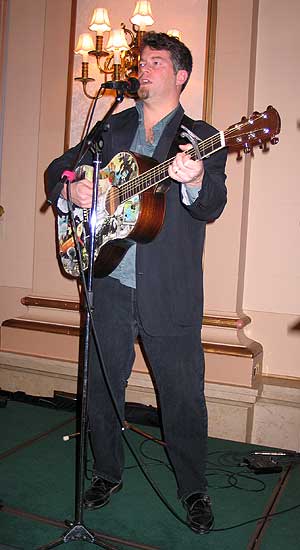
Mike Ford performs at the Macdonald Dinner
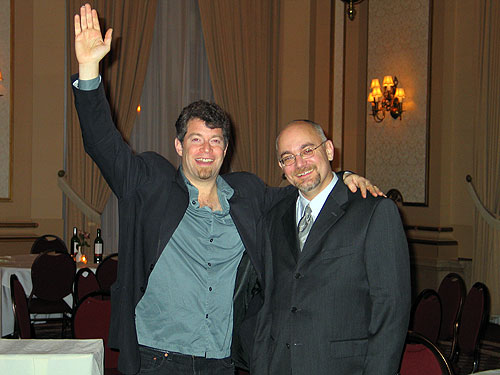
Mike Ford and Gordon Goldsborough
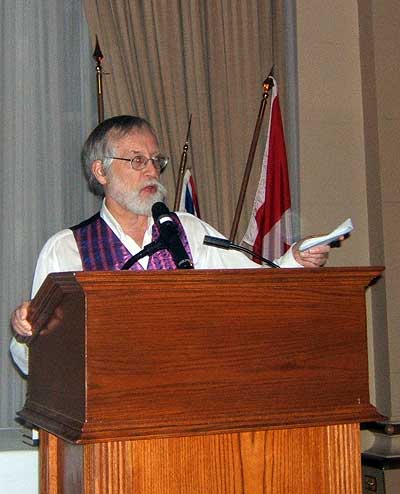
Master of Ceremony Ron Robinson
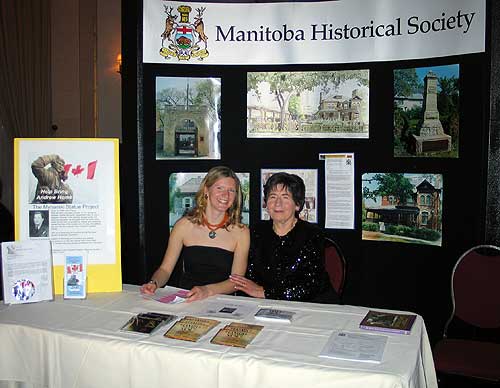
Kasia Dyszy and Mary Louise Zorniak

Shirley Bradshaw inspects the Silent Auction items
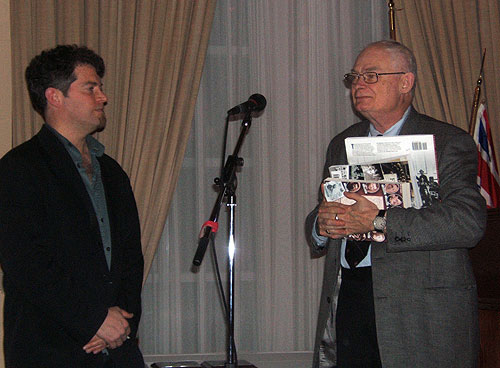
Mike Ford receives books from Dr. Jack Bumsted
 Hon. Peter Bjornson brings greetings from the Province of Manitoba |
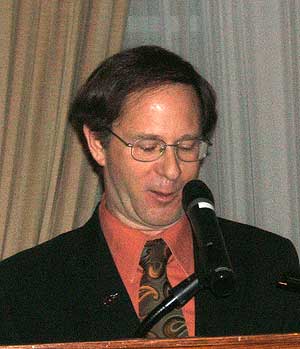 Donald Benham brings greetings from the City of Winnipeg |
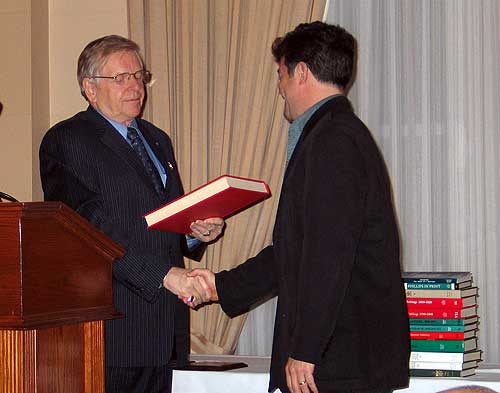
The Hon. John Harvard presents a Manitoba Historical Atlas to Mike Ford
The Manitoba Centennial Business Awards were established in 1999 by the Manitoba Historical Society to recognize businesses that had contributed to the development and character of the province for over one hundred years. Three awards were presented at the Sir John A. Macdonald Dinner.
The Alsip family still operates Alsip’s Industrial Products Limited in the same location and in the original building where the family began manufacturing brick in the late 1800s. In 1905 the Alsip Brick, Tile & Lumber Company was incorporated. In masonry, just one of their many lines, Alsip’s products have been used in the construction of everything from the Legislative Buildings, the Law Courts, and the original buildings at the Forks to many of Winnipeg’s elegant brick homes.
By 1959 brick manufacturing was discontinued but the family continues to operate the company as a major supplier of construction materials. Company president is F. Wayne Alsip and his two sons, Jason and Brad, are directors. Brad Alsip accepted the award from Judith Hudson Beattie.
By 1905, William J. McMartin’s metal shop, Winnipeg Ceiling and Roofing Company, sold many metal products such as corrugated iron, ornate metal ceilings, siding and windows. In 1921 his brother Hector took over the company, changed the name to Western Steel Products Limited and added oil barrels and corrugated steel-sided oil barrels to the product line. Since 1930 the company has operated under the trade name Westeel and there have been several changes of ownership. It is now a division of Vicwest Operating Limited Partnership of Oakville, Ontario. The Westeel 143,000 square foot plant in St Boniface produces steel products for storage of grain, fertilizer, seed and oil throughout the world. David Deane presented a Centennial Business Award to Mark Humphrey, General Manager - Agricultural Division, Westeel, honouring one hundred years of contributing to Manitoba’s economy.
In July 1905 brothers Ed (E. J.) and William (W. H.) Guinn arrived in Neepawa from Ontario, and established their company, the Neepawa Marble & Granite Works. By 1912 they had bought out an established monument company in Portage la Prairie, and joined with the undertaker, John (Jack) Simpson, to form Guinn & Simpson. Jack Simpson’s name is familiar, since he was the maternal grandfather of the author Margaret Laurence. Her books show how she was influenced by her grandfather’s firm.
In about 1925, Ed and William split the business: Ed continued with Guinn & Simpson in Portage, and William took on the Neepawa operation, using the name Neepawa Stone & Marble Works. After World War II, William’s sons operated the Neepawa business under the name Guinn Bothers, until it was sold out of the family in the 1976. Meanwhile, Ed Guinn continued as owner-operator of the Portage business until his death in 1956. His son, J. Murray Guinn entered the business before the war, and returned to it after five years war service, retiring in 1993. His son, Clark Murray Guinn, joined on a full-time basis in 1973 and still runs the business with another shareholder, Joe Cooper. Ken Zealand presented the award to Clark Guinn.
The Archives of Manitoba is pleased to announce the launch of the Keystone Archives Descriptive Database. Keystone provides searchable descriptions of the holdings of the Archives of Manitoba, including records of the Manitoba government, the Hudson's Bay Company, and individuals, families and private organizations. Descriptions are linked to item-level listings and to administrative histories and biographical sketches of record creators. Visit the Archives of Manitoba website at www.gov.mb.ca/archives or the Keystone site directly at www.gov.mb.ca/archives/keystone.
Islay School No. 733, located in the village of Vista, MB, came into being in 1893 to serve a small rural community of pioneer families. It grew from one to three rooms, and during that time until its final amalgamation with Rossburn as part of the Pelly Trail School District in 1968, produced approximately 522 alumni. A dedicated team of volunteers decided that an alumni reunion should be held to celebrate the history and initiative of the founders, the community and the graduates. This event will be held 04-05-06 August 2006 at the Rossburn Agric-Rec Centre. Alumni, friends, and community are invited to join the celebration. In addition to the school reunion, a community celebration of the arrival of the first CNR train in 1906 will be held. This is in recognition of the contribution of the railroads to agricultural development in western Manitoba. The tracks were removed in 1996, and the elevators closed about that time too. The ravages of time, economics and transportation have had their effects on this currently small community of 22 people, which still boast one of the few general stores in the nation. If you would like more information about the reunion, or about the book which will document the alumni, teachers, trustees, veterans, centennial farms, and historic community events contact: Gerald R. Brown, 3403 - 55 Nassau Street North, Winnipeg, MB R3L 2G8, phone 204-284-5620 or e-mail to browner1@mts.net.
St. Boniface Museum has unveiled a collection of artifacts pertaining to the history of St. Boniface Cathedral. The collection, “A Beacon of the Red: the Cathedrals of St. Boniface” includes a cornerstone, door handles, a robe, bells, pictures and information on the earlier cathedrals’ builders, the bishops.
The Great Canadian Travel Company will be working with the Métis community and others in preparation for the Orkney Homecoming 2007. In May of 2007 the North American descendants of the original Hudson Bay Company men will meet in the Orkney Islands to reaffirm old relationships and forge new ones. The event is focused on reuniting the historic bonds between the Old World and the New. Whether your interest is familial, genealogical, historical or cultural, the Orkney Homecoming offers its participants a taste of the unique qualities of Orkney, both ancient and contemporary. Details of the Orkney Homecoming 2007 program are available at www.orkneyhomecoming.com.
Descendants of Jean-Baptiste Lagimodière and Marie-Anne Gaboury, the grandparents of Louis Riel meet this summer to celebrate the 200th anniversary of their arrival in the Northwest. Reunion organizers, in partnership with the St. Boniface Historical Society are planning several events between July 28 and 30, including a parade and a banquet and gathering at Fort Gibraltar.
Dr. Jack Bumsted, MHS vice president, spoke at a luncheon of The Manitoba Branch of the United Empire Loyalist Association of Canada on January 17. The topic was “Sir John A. Macdonald and the Pacific Scandal” Future UEL events include the Prairie Regional Conference which will take place in Brandon on April 21 – 23. Part of the conference will be a tour of the Commonwealth Air Training Museum.
Premier Gary Doer has announced the Manitoba has proclaimed 2006 the Year of the War Bride, marking the 60th anniversary of most of the war brides’ arrival in Canada. The proclamation was presented on behalf of the premier by St. James MLA Bonnie Korzeniowski in a ceremony on February 9 on pier 21 in Halifax. The first ship carrying war brides landed there on February 9, 1946. More than 45,000 women, mainly from the United Kingdom, married Canadian servicemen who were stationed overseas.
Minnedosa United Church
The Minnedosa United Church, a historic landmark built in 1901, was destroyed by fire on February 12th. In addition to serving in its role as a church it was a popular place for concerts, youth activities and community events over the past century. The RCMP promptly charged three people with arson in relation to the fire.
22 February: Dr. Stuart Houston speaking on Eighteenth Century Naturalists of Hudson’s Bay McGill-Queens, 2003 (also MHS Program)
3 March: Pat Challis, on John C Charyk, Syrup Pails and Gopher Tails: Memories of the One-Room School, Western Producer Books, 1983 (10 in library under 372.9712CHA)
17 April: Dodie Metcalfe, on Ken McGoogan, The Revenge of Lady Franklin.
Inc./L'Association du Corridor Riviere Rouge Inc. and the province of Manitoba are working towards the designation of the Red River as a Canadian Heritage River. The Red was nominated into the Canadian Heritage Rivers System in 2005 as a candidate Canadian Heritage River. Over the next year, Rivers West and the province of Manitoba will be participating with citizens, river users, stakeholders and First Nations along the river to prepare a Red River designation document. The designation document must describe how the river is managed to conserve its outstanding cultural, natural and recreational values Rivers West is organizing workshops for Government, First Nations, and stakeholders to obtain further direct input for the preparation of the draft designation document.
What do we - as citizens and government – do right now to conserve Red River heritage and recreational values? What we can do better to enhance those values and ensure their continued use and enjoyment by future generations?
There were two workshops for stakeholders: February 22, 2006 and February 23, 2006. If you have any questions or concerns regarding the designation of the Red River, please contact by email at lhendricks@gov.mb.ca or phone 204-945-7733.
Lorna Hendrickson
Rivers West - Red River Corridor Association Inc.
201 - One Forks Market Road
Winnipeg, Manitoba R3C 4L9
phone: 204.945.7733 or 204.987.4356
fax: 204.943.7915
websites: www.routesonthered.ca and www.riverswest.ca
Call for Papers and Presentations
Annual Conference 2006
Heritage in an Electronic Age
Ottawa, Ontario, October 12 to 14, 2006
The electronic age is having a profound affect on heritage conservation. Some of the key uses of the new technology in heritage include: creating and managing inventories and registries of property and artifacts, rehabilitation and restoration project management, developing multi-dimensional models of heritage sites, promoting conservation through web and internet communications, and developing new ways of working with broadcast media. The 2006 annual conference will examine heritage conservation in an electronic environment, featuring presentations on currents trends, demonstrations of tools now being developed, and workshops on how to take advantage of technology to advance heritage conservation. The sessions will be organized around four streams:
The Heritage Canada Foundation invites proposals for papers, presentations, panel discussions, seminars and workshops. Please submit an abstract or description, not to exceed 250 words, by February 28, 2006.
Heritage Canada Foundation
5 Blackburn Avenue
Ottawa ON K1N 8A2
Email: heritagecanada@heritagecanada.org
Click here for an updated list of Centennial Farm recipients.
by Tim Worth
This International style of architecture developed in Europe and the United States in the 1920s and '30s and became the dominant tendency in Western architecture during the middle decades of the 20th century. The most common characteristics of International Style buildings are rectilinear forms; light, surfaces that have been completely stripped of applied ornamentation and decoration; open interior spaces; and in some interpretations a visually weightless quality engendered by the use of cantilever construction. Glass, steel, and reinforced concrete, are the characteristic materials of construction. The clean, geometric qualities of the style came to form the basis of the construction of the skyscraper.
The new use of steel-reinforced concrete as secondary support elements (floors, etc.) and of glass as sheathing for the exteriors of buildings completed the technology needed for modern building, and architects set about incorporating that technology into an architecture that openly recognized its new technical foundation.
In Winnipeg there are many interesting examples of this style, the former New York Life Insurance Building – 385 St. Mary’s Avenue, the Norquay Building, the former Monarch Life Building – 333 Broadway, the School of Architecture at the University of Manitoba and the Royal Bank Building – 220 Portage Avenue.
Norquay Building
During the 20th century, particularly following the Second World War, development and rebirth took place a quick pace. The “modern” period of architectural style was easily influenced by new radical ideas resulting in a mix of styles. Walk down any downtown street and it will clearly show what Winnipeg architect, John White, says, “Most buildings in Winnipeg are a hybrid amalgam of various different styles and design influences.”
The International style of architecture has also been applied to many residential structures. In its interpretation in a residential application it exhibits minimal complication of form, lacks regional characteristics, and rejects all nonessential decorative elements.
Taking the “International style” at face value, we can see that it reshaped the look of our cities in the 20th century and lent form to the architecture that will arise during the 21st century.
Nominations for membership on the MHS Council are requested, and should be submitted to the MHS office at least two weeks before the Annual General Meeting, scheduled for Saturday, 27 May 2006. The Council is the governing body of the MHS, and is responsible for its general management and supervision of Society affairs. It meets on a weekday evening every two months (except during summer), usually at Dalnavert Museum. Councillors serve a three-year term. Completed nominations should include the name and address of the nominee, the name of the nominator, and an indication that the nominee accepts the nomination. Self-nominations are welcome.
Nominations are also being accepted for membership on the Executive Committee, which is responsible for day-to-day decision-making on behalf of the Council. It meets monthly, or as needed, usually at the MHS office. Executive membership is a two-year term. Positions on the Executive Committee include President, First Vice-President, Second Vice-President, Treasurer, and Secretary.
This year the MHS will be holding its annual general meeting on Saturday, May 27 in Emerson, Manitoba. More details will follow in next Time Lines and on MHS web site.